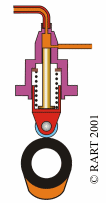Fuel Pump
| Two different methods are used. In the first, the plunger has a helix machined into it which also forms a vertical groove and an annular groove at the base of the helix. The plunger reciprocates in a barrel, located in the pump body which has spill ports, connected to the suction side of the pump, drilled so that they are above the top of the plunger when the cam is on the base circle. The plunger is keyed to a sleeve which has a gearwheel (pinion) machined into it. The pinion meshes with a rack which can rotate the plunger relative to the barrel. The rack is connected to the engine governor. |
As the plunger moves upwards in the barrel, injection will commence once the plunger has closed off the spill ports and the pressure builds up. As soon as the helix or scroll passes the spill ports the pressure above the plunger will immediately drop, even though the plunger is still moving upwards. It should therefore be evident that the amount of fuel injected into the cylinder is dependent on the position of the helix relative to the spill port. When the vertical groove is lined up with the spill port, then no injection will take place and the engine will stop.
In the example shown the plunger has a single helix machined into it. More common are pumps with two helices (and thus two no load grooves) diametrically opposite each other. This gives a balanced plunger.
The plunger is machined to very fine tolerances, as is the matched barrel in which it reciprocates. Wear due to abrasive particles in the fuel will mean that the pump will take longer to build up the injection pressure required. Wear due to erosion also takes place on the top edge of the plunger and the edge of the helices and spill ports. This, together with the wear in the plunger and barrel, will lead to the injection timing becoming retarded, for which adjustment may have to be made.
| On the scroll or helical fuel pump previously described, although the end of injection can be varied, the start of injection (i.e. when the top of the plunger covers the spill ports) is fixed. Fuels of different qualities may require advancing or retarding the injection timing, in addition to which if the injection timing is advanced when the engine is running at loads below the maximum continuous rating, then a saving in fuel can be achieved. This method of varying the injection timing (known as Variable Injection Timing) can be achieved by the method shown. The bottom of the barrel has a coarse screw thread cut into it. This is located in a threaded sleeve which is turned by a rack and pinion. The barrel is free to move up and down in the pump casing but cannot rotate. This means that as the threaded sleeve is rotated by the VIT rack the position of the spill ports relative to the barrel is changed, thus altering the start of injection. |
| The second method of controlling the quantity of fuel is by using suction and spill valves operated by push rods. The principle is illustrated opposite. A plain plunger reciprocates in a barrel. As the plunger moves up and down, two pivoted levers operate push rods which open the suction and spill valves. When the cam follower is on the base circle of the cam, the suction valve is open and the spill valve is closed. As the plunger moves up the barrel, the suction push rod moves downwards and the suction valve closes. Injection then commences and fuel is delivered via a non return valve to the injectors. As the plunger continues upwards so the spill push rod will open the spill valve, the pressure above the plunger will fall and injection will cease. The quantity of fuel delivered can be controlled by altering the position of the eccentric pivot for the spill valve operating lever. This will cause the spill valve to open earlier or later. By altering the position of the suction valve pivot, the start of injection can be similarly controlled, and therefore it can be seen that the pump utilises VIT. |






Comments
Post a Comment